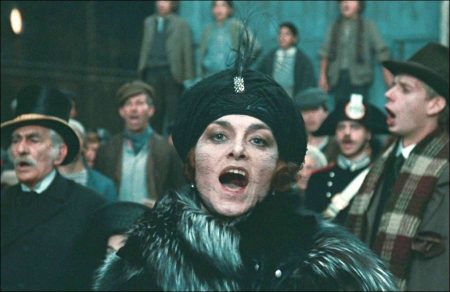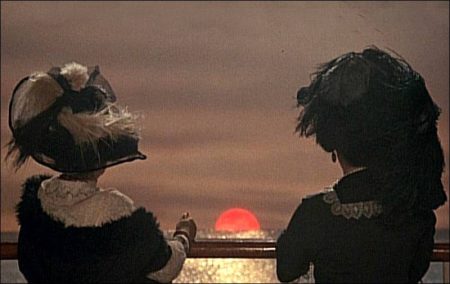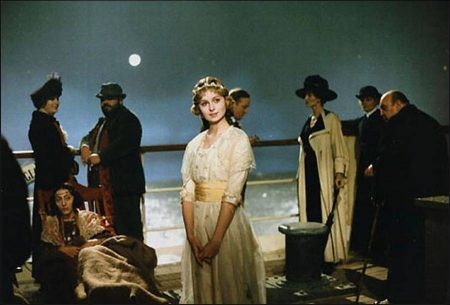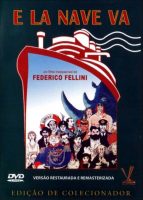And the Ship Sails On opens depicting a scene in July 1914 immediately prior to the cruise ship Gloria N. setting sail from Naples Harbor. The opening sequence is in sepia tones, as if it were a film shot in that era, with no sound other than the whirring of the projector. Gradually the sepia fades into full colour and we can hear the characters’ dialogue.
Orlando, an Italian journalist, supplies commentary by directly addressing the camera, explaining to the viewer that the cruise is a funeral voyage to disperse the ashes of opera singer Edmea Tetua near the island of Erimo, her birthplace. Considered the greatest singer of all time, Tetua is celebrated for her goddess-like voice.
The bumbling but lovable journalist also provides highly subjective anecdotes and gossip on the wide array of cartoon characters that evoke the golden age of the “funny papers” (Little Nemo[citation needed], Bringing Up Father[citation needed], The Katzenjammer Kids[citation needed]) but with a perverse Felliniesque twist. These include more opera singers, voice teachers, orchestra directors, theatre producers, actors, prime ministers, counts, princesses, Grand Dukes, and panic-stricken fans of the deceased diva.
A jealous and bitter soprano named Ildebranda desperately tries to penetrate the secret behind Edmea Tetua’s unforgettable voice. A bristle-haired Russian basso is shown around the ship’s vast mess hall where, using only his voice, he hypnotizes a chicken. A curly-cued actor travels with his mother in order to seduce sailors. Sir Reginald Dongby, a voyeuristic English aristocrat, relishes spying on Lady Violet, his nymphomaniac wife.
The Grand Duke of Harzock, a Prussian, is an obese bubble of a young man whose blind sister (the Tanztheater performer and choreographer Pina Bausch) schemes with her lover, the prime minister, to disinherit her brother. The brooding Count of Bassano closets himself in his cabin transformed into a temple dedicated to the diva’s memory. An awful stench rises from the ship’s hold and soon it’s revealed that a love-sick rhinoceros has been neglected by the ship’s crew. The beast is pulled up, washed on deck, and returned to the hold with fresh water and hay.
On the third day of the voyage, the passengers discover a crowd of shipwrecked Serbians camped on the deck of the ship. Fleeing in rafts towards Italy after the assassination at Sarajevo, the refugees were brought on board the previous night by the captain. The Grand Duke and his men, however, are convinced the Serbians are terrorists and order the captain to isolate the group to a corner of the ship. The upshot is Fellini’s barely disguised take on the Marx Brothers’s A Night at the Opera in a heady mix of cultures, both ethnic and artistic, where aristocrats and snobs joyfully share the stage (the ship’s deck) with peasants and vibrant Serbian folklore (as choreographed by Leonetta Bentivoglio[2]).
But the revels end when the menacing flagship of the Austro-Hungarian fleet sails into view, demanding the return of the Serbian refugees. The captain agrees on condition that Edmea Tetua’s ashes be dispersed at Erimo beforehand. After the ceremony, the refugees are loaded into a lifeboat for delivery to the Austrians but a young Serbian hurls a bomb at the flagship, causing pandemonium. The Austrians respond by cannon fire. The Gloria N. sinks while Albertini wields his baton, aristocrats march to the lifeboats, a grand piano slides across the floor smashing mirrors, and butterflies twitter serenely above the melee of suitcases in flooded corridors.
And the Ship Sails On (Italian: E La Nave Va) is a 1983 Italian film directed and co-written by Federico Fellini. It depicts the events on board a luxury liner filled with the friends of a deceased opera singer who have gathered to mourn her. The film was selected as the Italian entry for the Best Foreign Language Film at the 56th Academy Awards, but was not accepted as a nominee.
Film Review for And the Ship Sails On
In And the Ship Sails On, I needed a large exterior to paint, so I used the wall of the Pantanella pasta factory. It was where my father, Urbano Fellini, had worked when he passed through Rome on his way back from forced labor in Belgium after World War I. It was while at the pasta factory in 1918 that he met my mother, Ida Barbiani, and carried her off, not on a white charger, but in a third-class coach on the train, with her full consent, away from her home, family, and social class in Rome.
By the time I made Intervista, from the perspective of the years that had passed, I had a better understanding of my parents than the view I had in my own youth. I had come to feel close to my father, and I fervently wished I could tell him so. I understood my mother better, too, and I no longer resented our differences. I recognized that life had not given either of them what they wanted, but I tried to give them in retrospect the understanding I gave to the characters in my films.
The deck of the ship in And the Ship Sails On was constructed on Stage 5 at Cinecittà. It was supported on hydraulic jacks and rocked realistically. Everyone but me was seasick. It was not because I am such a good sailor, but because I was so intensely involved in what I was doing that I was not aware of the rocking. The sea was created from polyethylene. The obviously artificial painted sunset looked beautiful. The appearance of artificiality is deliberate. At the end, I reveal the set and me behind a camera, the entire magic show.
I wasn’t certain about casting Freddie Jones in the role of Orlando. He would be a British type playing an Italian in a Mediterranean setting. Yet there was something about him that appealed to me for the part. After our initial interview, I rode with him to the airport. On the way back to Rome, I was still unsure. Then I saw a bus which had a large sign advertising Orlando ice cream. I took it as a favorable omen and allowed it to make the decision for me. Besides, I didn’t really have anyone else in mind.
In the opening, I show the contrast between the rushed confusion of the luxury liner’s first-class galley and the slow, stately pace of the dining room. The rich eat very slowly. They never have to worry about shortages. They are more concerned about how they look while chewing.
I was concerned about having lovely food for the people to eat. It had to be photogenic so it would look enticing on the screen. I wanted food that was fresh and deliciously prepared for inspiring the actors. It was important that it smelled good, and we looked forward to eating it afterwards. Maybe everyone did better and there were fewer takes so we could finish before the food got cold.
There is nothing too small for me to do on the set. I move a table, I arrange someone’s curl, I pick up a piece of paper from the floor. It is all part of making the film. At home, I cannot make a cup of coffee because I am too impatient to wait for water to boil.
And the Ship Sails On has a great deal to do with opera, a subject I would have avoided in my earlier pictures. It was only in later life that I came to appreciate our Italian operatic tradition. I suppose the reason I said and wrote so much about not liking opera is because every Italian is supposed to love opera, especially every Italian man. My brother, Riccardo, went around the house singing. Love of opera isn’t restricted to Italy, of course, but it’s more widespread here than in America.
All my life I’ve had a natural resistance to whatever everyone likes, or wants, or is “supposed” to do. I never was interested in soccer, either to play or to watch, and for a man to admit that in Italy is almost like admitting that you aren’t a man at all. I do not like to belong to political parties or to clubs. Partly this is probably in my black-sheep nature, but I think another very real reason is I remember the Black Shirts.
I was a child in a time when we wore the outfits of our school, or we wore the black shirts of fascism, and we were supposed to question nothing. That has made me question everything. I was always suspicious, not wanting to be one of the sheep going to slaughter. So sometimes I may have missed out on a pleasure the sheep enjoyed which I could have had without becoming a lamb chop.
Now I have developed a late interest in opera, but it’s difficult to admit you have interest in a subject in which you have vehemently denied having any interest for so long. I have not seen the film since it was finished, but I wonder how it would seem now in light of what has been happening in Yugoslavia. Would it seem too light, too dated? Or would it speak to audiences more clearly?
The rhinoceros is a distant cousin of the sick zebra I helped to wash when I was a boy and the circus came to Rimini. My theory about why the zebra was sick is that he didn’t have any sex in his life. How could he feel well? There was, after all, only one zebra in that circus. The rhinoceros is lovesick.
Only one rhinoceros is the same as only one zebra.
And the Ship Sails On (1983)
Directed by: Federico Fellini
Starring: Freddie Jones, Barbara Jefford, Victor Poletti, Peter Cellier, Elisa Mainardi, Norma West, Paolo Paoloni, Sarah Jane Varley, Fiorenzo Serra, Pina Bausch, Pasquale Zito
Screenplay by: Federico Fellini, Tonino Guerra
Production Design by: Dante Ferretti
Cinematography by: Giuseppe Rotunno
Film Editing by: Ruggero Mastroianni
Costume Design by: Maurizio Millenotti
Set Decoration by: Francesca Lo Schiavo, Massimo Tavazzi
Art Direction by: Maria-Teresa Barbasso, Nazzareno Piana, Massimo Razzi
Music by: Gianfranco Plenizio
MPAA Rating: None.
Distributed by: Gaumont
Release Date: September 7, 1983
Visits: 193




